| 200 BC - AD 429 |
The Berbers of North Africa are conquered byRome and remain within the republic and empire for the next seven hundred years.  The Hoggar Mountains today sit in southern Algeria, but they cover an area of the Sahara and provided a western border to the northern reaches of the Kanem empire The Hoggar Mountains today sit in southern Algeria, but they cover an area of the Sahara and provided a western border to the northern reaches of the Kanem empire |
|
|
| 429 - 534 |
Under pressure from the newly settled Visigoths, the [Vandali](../KingListsEurope/BarbarianVandals.htm#Vandals and Alans) and Alani move south from Iberia and invade Roman North Africa. An independent autocracy is formed in modern Tunisia and north-eastern Algeria. To its west a Mauro-Roman kingdom is established in what had been theRoman province of Mauretania Caesariensis. It sometimes vies with the Vandali and their successors, the Eastern Roman prefecture ofAfrica, for regional superiority. In 578 troops of the Mauro-Roman kingdom invade the prefecture of Africa. With diplomatic ties with the kingdom having broken down, Gennadius is appointed as magister militum Africae to deal with the problem. King Garmul is swiftly defeated and his kingdom collapses. Part of it is incorporated into the prefecture while other areas become incorporated into Berber states. |
|
|
| 534 - 698 |
North Africa is re-conquered by the Eastern Roman empire from the[Vandali](../KingListsEurope/BarbarianVandals.htm#Vandals and Alans) in just one campaigning season and two major battles, both of which the Vandali lose. 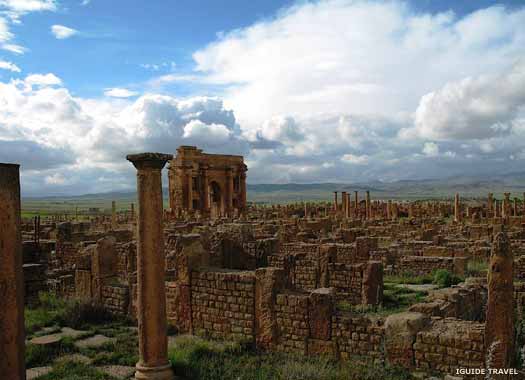 What are now Roman ruins at Batna in Algeria would still have been largely habitable during the Byzantine ownership of the region, some seven hundred years after the first Roman settlement there What are now Roman ruins at Batna in Algeria would still have been largely habitable during the Byzantine ownership of the region, some seven hundred years after the first Roman settlement there |
|
|
| 698 - 776 |
Western North Africa is separated from the Eastern Roman empire by the Islamic empire. The native Berbers remain mainly in the mountainous regions, resisting the spreading Arab influence. They manage to preserve much of their language and culture in the process. |
|
|
|
|
|
|
| Rustamid Imams AD 776 - 909 The Rustamids (variously, Rustumids, or Rostemids) ruled the central Maghreb for a century and a half from their capital at Tahert in present Algeria until it was destroyed. The state's extent is not entirely clear, but it stretched as far east as Jabal Nafusa in Libya. |
|
|
|
| 776 - 784 |
Abd ar-Rahman ibn Rustam ibn Bahram |
|
|
| 784 - 832 |
Abd al-Wahhab |
Son. |
|
| 800 - 812 |
The Aghlabid emirs of Tunisia claim to rule Algeria. |
|
|
| 832 - 871 |
Aflah ibn Abd al-Wahhab |
Son. |
|
| 871 |
Abu Bakr ibn Aflah |
Son. |
|
| 871 - 894 |
Muhammad Abul-Yaqzan ibn Aflah |
Brother. |
|
| 894 - 897 |
Yusuf Abu Hatim |
Son. |
|
| 897 - 901 |
Yaqub ibn Aflah |
Son of Aflah ibn Abd al-Wahhab. |
|
| 901 - 906 |
Yusuf Abu Hatim |
Restored. |
|
| 906 - 909 |
Yaqzan ibn Muhammad Abil-Yaqzan |
Brother. |
|
| 909 - 1171 |
With the Rustamids now militarily weak, they prove easy prey for conquest by theFatamid emirs of Tunisia. In 1082-1083, formerly Rustamid Algiers, Ténès, and Oran are conquered by the Almoravids from western Africa. |
|
|
| 1171- 1229 |
TheAyyubids of Egypt take control in Algeria. |
|
|
| 1229 - 1518 |
Algeria becomes a battleground forHafsids of Tunisia, the Merinids of Morocco, and the Western Algerian Abdul-Wadids and Zayyanids, with rule alternating between them for periods. |
|
|
|
|
|
|
| Abdul Wadids / Zayyanid Dynasty (Kingdom of Tlemcen) AD 1236 - 1555 The Zayyanids (Zayyaniyyun, or Ziyyanids) were a dynasty of Zanatah Berbers who ruled western Algeria. They were based at the inland city of Tlemcen (Tilimsan - the former Roman town of Pomaria) in western Algeria, and were at first loyal vassals to the Almohad caliphs in Morocco. The gradual collapse of the Almohad empire saw them break free and declare independence in 1236. The extent of Zayyanid territory fluctuated greatly throughout the dynasty's history. The Zayyanids experienced two peaks: during the late thirteenth and the early sixteenth centuries, they held most of Algeria, including large sections of the coast. But throughout their history, they were vulnerable to attacks from their Merinid and Hafsid neighbours, as well as to tribal unrest inside their own dominions. In the 1230s another group of Zanatah Berbers, the Banu 'Abd al-Wad ('Abd al-Wadid dynasty), took control of the region of Tlemcen. The state they founded there was overrun several times in the thirteen and fourteenth centuries. |
|
|
|
| 1236 - 1283 |
Yaghmurasan |
|
|
| 1269 |
The Zayyanids capture Marrakech, endingAlmohad rule in Algeria. North Africa breaks up between theHafsids,Merinids, and the Algerian Zayyanids). None of them are strong enough to reunite the empire and rule a strong North Africa, so they fight amongst themselves for pockets of territory, and none of them are dominant until the sixteenth centurySaadi dynasty comes to power. |
|
|
| 1283 - 1304 |
Abu Sa'id Uthman I |
|
|
| 1304 - 1308 |
Abu Zayyan I Muhammad |
|
|
| 1308 - 1318 |
Abu Hammu Musa I |
|
|
| 1318 - 1337 |
Abu Tashufin 'Abd al-Rahman I |
Died defending Tlemcen. |
|
| 1337 - 1347 |
With the Zayyanids now in command of Tunis, the dispossessed Hafsids appeal for help to the Merinids of Fez. Only too glad to have an excuse of expanding the Merinid kingdom at the expense of one of his neighbours, Sultan Abu al-Hasan ibn Uthman invades and captures Tlemcen in 1337. With the Zayyanid ruler dead in battle, the Merinids now control Zayyanid territory. |
|
|
| 1347 - 1348 |
The Merinids of Fez take the opportunity presented to them by the bickering Hafsids and invade Ifriqiyya. Having already captured Tlemcen from the Zayyanids, for a brief period the territories of the former Almohad kingdom are reunited under one ruler. However, Sultan Abu al-Hasan of Fez is defeated in 1348 by Arab tribes who resent his authoritarian attitude. The sultan's son returns to Fez from his governorship at Tlemcen and declares himself sultan. Abu al-Hasan is unable to recapture his throne. The Zayyanids instantly rebel, overthrow their Merinid invaders and retake their kingdom under Abu Sa'id Uthman II. 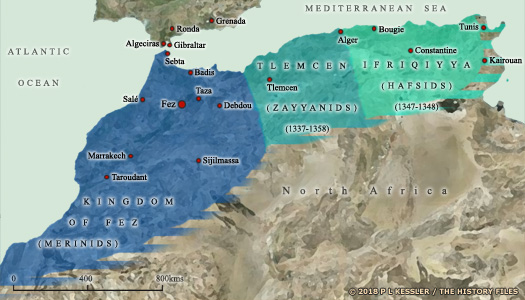 The kingdom of Fez under Merinid control made the most of the confused political situation in North Africa by pouncing on the Zayyanids in 1337 and then on the Hafsids in 1347 to briefly recreate the former Alhomad kingdom (click or tap on map to view full sized) The kingdom of Fez under Merinid control made the most of the confused political situation in North Africa by pouncing on the Zayyanids in 1337 and then on the Hafsids in 1347 to briefly recreate the former Alhomad kingdom (click or tap on map to view full sized) |
|
|
| 1348 - 1352 |
Abu Sa'id Uthman II |
|
|
| 1348 - 1352 |
|
al-Zaim Abu Thabit I |
Joint ruler. |
| 1352 - 1359 |
The Merinids again conquer areas of Zayyanid Algeria, but never as completely as before. Any Merinid success is brought to a crashing halt by the murder of Sultan Abu Inan Farais and the subsequent control of the kingdom by his vizir. The dynasty had already begun to decline during Abu Inan Faris' reign, but his murder begins a definite period of instability with the viziers raising several claimants to the throne in succession. |
|
|
| 1359 - 1360 |
Abu Hammu Musa II |
d.1389. |
|
| 1360 |
Abu Zayyan Muhammad II ibn Uthman |
d.1387. |
|
| 1360 - 1370 |
Abu Hammu Musa II |
Restored. |
|
| 1370 - 1372 |
Abu Zayyan Muhammad II |
Restored. |
|
| 1372 - 1383 |
Abu Hammu Musa II |
Restored. |
|
| 1383 - 1384 |
Abu Zayyan Muhammad II |
Restored. |
|
| 1384 - 1387 |
Abu Hammu Musa II |
Restored. |
|
| 1387 |
Abu Zayyan Muhammad II |
Restored. |
|
| 1387 - 1389 |
Abu Hammu Musa II |
Restored. |
|
| 1389 - 1394 |
Abu Tashufin Abd al-Rahman II |
|
|
| 1394 |
Abu Thabit Yusuf I |
|
|
| 1394 - 1395 |
Abu'l-Hajjaj Yusuf II |
|
|
| 1395 - 1400 |
Abu Zayyan Muhammad III |
|
|
| 1400 - 1402 |
Abu Muhammad Abdallah I |
|
|
| 1402 - 1411 |
Abu Abdallah Muhammad IV al-Wathiq |
|
|
| 1411 |
Abu Tashufin Abd al-Rahman III |
|
|
| 1411 |
Sa'id Ibn Musa |
|
|
| 1411 - 1424 |
Abu Malik Abd al-Wahid |
|
|
| 1424 - 1428 |
Abu Abdallah Muhammad V |
|
|
| 1428 - 1430 |
Abu Malik Abd al-Wahid |
Restored. |
|
| 1430 |
Abu Abdallah Muhammad V |
Restored. |
|
| 1430 - 1462 |
Abu'l-Abbas Ahmad I al-Aqil |
|
|
| 1462 - 1469 |
Abu Abdallah Muhammad VI al-Mutawakkil |
|
|
| 1469 |
Abu Tashufin III |
|
|
| 1469 - 1504 |
Abu Abdallah Muhammad VII at-Thabiti |
|
|
| 1504 - 1517 |
Abu Abdallah Muhammad VIII at-Thabiti |
|
|
| 1506 |
The Spanish of the kingdom of Castile capture the city of Mostaganem. The city's harbour proves an invaluable addition to Castile's other recent holdings along the North African coast, including Melilla (which had been captured in 1496), and Mers-el-Kebir (taken in 1505). |
|
|
| 1510 |
The Spanish of Castile establish themselves on a small island called Peñón de Algiers which is situated in the waters immediately outside Algiers. The local amir, Selim al-Toumi at-Thabiti, a relative of the Zayyanid ruler, Abu Abdallah Muhammad VIII, is forced to accept this European presence by signing a treaty and paying tribute to the new arrivals. The island is fortified using the latest military technology. Selim is also forced to travel to Spain to take an oath of obedience to King Ferdinand. This is at a time in which the Barbary Corsairs are coming to prominence in the region. |
|
|
| 1516 - 1517 |
Having been invited to Algiers by Selim al-Toumi at-Thabiti to aid him in his troubles with theSpanish, the Barbary Corsair Aruj al-Din Barbarossa captures the city instead, orders Selim's assassination, and moves his base of operations there. The Spanish military outpost of Peñón de Algiers on the small island in the waters immediately outside Algiers remains untouched, however. Realising the extent of the task ahead of him, especially when the Spanish send a mission to attempt the recapture of Algiers, Aruj requests the support of theOttoman empire in the following year. |
|
|
| 1517 - 1518 |
Abu Hammu Musa III |
Deposed. |
|
| 1518 - 1519 |
Barbary Corsair Aruj al-Din Barbarossa captures the majority of Zayyanid territory before he is killed by theSpanish whilst trying to capture the capital of Tlemcen. Abu Hammu Musa III is briefly deposed by this invasion as Aruj's brother, Khayr, takes over as the military commander of Algiers. A Spanish attempt to retake Algiers in the following year fails. |
|
|
| 1518 - 1528 |
Abu Hammu Musa III |
Restored. |
|
| 1520 - 1525 |
Algiers is attacked by the Kuku tribal leader Ahmad ibn al-Qadi and theHafsids. The leader of the Barbary Corsairs, Khayr al-Din, retreats to Jijelli and increases his privateering. He re-conquers Algiers in 1525, massacring Arabs and Kabyles who resist him. WithOttoman support he is able to establish the regency of Algiers, the key Ottoman centre of power in the Mahgreb, as well as creating a base for privateering against European trading vessels in the Mediterranean. |
|
|
| 1528 - 1540 |
Abu Muhammad Abdallah II |
|
|
| 1532 |
As the Ottoman empire's official representative, the Barbary Corsair, Khayr al-Din Barbarossa, becomes the first official beylerbey of Algiers, pushing aside the existing Zayyanid governor in the region in the form of Abu Muhammad Abdallah II. Barbarossa retains the post until his death. He controls an area of territory that closely matches the extent of modern Algeria's borders, and he also begins to threaten the power of the neighbouring Hafsids. |
|
|
| 1540 - 1541 |
Abu Abdallah Muhammad IX |
First official Ottoman beylerbey of Algiers. |
|
| 1541 |
The military ventures of King Charles of Spain against the Hafsids of Ifriqiyya (in 1535) and now against the Zayyanids themselves are failures. Subsequently, he is forced to defend Spanish territories in the Mediterranean from raids by the piratical Barbary Corsairs. Part of this effort means that theSardinian coast is fortified with a chain of defensive lookout towers. |
|
|
| 1541 - 1543 |
Ahmad II |
|
|
| 1543 |
Abu Abdallah Muhammad IX |
Restored. |
|
| 1544 - 1550 |
Ahmad II |
Restored. |
|
| 1549 - 1554 |
Saadi ruler Mohammed ash-Sheikh defeats the Wattasids to take control of Fez, heartland of the northern Moroccan kingdom of Fez. In the same year he is able to seize Tlemcen, ending Zayyanid rule there. Wattasid Sultan Abu al-Abbas Ahmad is forced to seek refuge with the Ottoman beylerbey in Algiers. |
|
|
| 1550 - 1555 |
al-Hassan |
|
|
| 1555 |
A combination of Spanish encroachment along the coast and the intervention of the Ottoman empire, with the latter ostensibly taking up the Muslim cause against Christian aggression, causes Algeria to be subsumed within the Ottoman empire. The Zayyanids are finally overthrown in Tlemcen by the ruler ofMorocco, Mohammed ash-Sheikh. Much of the region outside Tlemcen is governed as an autonomous province from the Barbary Corsair capital at Algiers. |
|
|
|
|
|
|
| Regency of Algiers (Barbary Corsairs) c.AD 1517 - 1671 By about 1500, with Hafsid support, the Barbary corsairs were attempting to establish a nominally independent Algiers state. They battled Spanish and Zayyanids alike, initially from a base along the Tunisian coast. Ultimately they succeeded and, known colloquially as the Barbary kings, they managed to sideline the ruling Zayyanids completely. Their efforts also focussed regional affairs on the coastal city of Algiers rather than the western inland city of Tlemcen. Quickly winning support from the Ottoman empire, the Barbary corsairs were granted the title of beylerbey in 1532 (the equivalent of a grand duke) and pasha in 1577. The term 'Barbary' was coined by Europeans to describe all of the North African territories that were inhabited by Berbers. This not only included the Mediterranean coastal areas, but deep inland too. Principally, this European attention was focussed on the highly troublesome Barbary pirates themselves, who continued their raids into the early eighteenth century, fully supported by the regency of Algiers. |
|
|
|
| ? - 1516 |
Selim al-Toumi al-Tha'alibi |
Amir of Algiers, and relative of the Zayyanid ruler. Assassinated. |
|
| 1510 |
The Spanish of Castile establish themselves on a small island in the waters immediately outside Algiers which they name Peñón de Algiers. The local ruler, Selim al-Toumi at-Thabiti, a relative of the Zayyanid ruler, Abu Abdallah Muhammad VIII, is forced to accept this European presence by signing a treaty and paying tribute to the new arrivals. The island is fortified using the latest military technology. Selim is also forced to travel to Spain to take an oath of obedience to King Ferdinand. 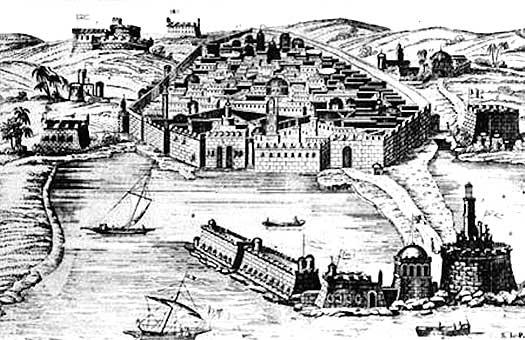 Algiers of this early modern period was a walled city with the Spanish Peñón de Algiers fort dominating its seaward approach - not that the Spanish had it all their own way when attempting to dominate the region Algiers of this early modern period was a walled city with the Spanish Peñón de Algiers fort dominating its seaward approach - not that the Spanish had it all their own way when attempting to dominate the region |
|
|
| 1516 - 1517 |
Having been invited to Algiers by Selim al-Toumi at-Thabiti to aid him in his troubles with theSpanish, Aruj al-Din Barbarossa captures the city instead, orders Selim's assassination, and moves his base of operations there. The Spanish military outpost of Peñón de Algiers remains untouched, however. Aruj is able to capture the Spanish port of Mostaganem but, realising the extent of the task ahead of him, especially when the Spanish send a mission to attempt the recapture of Algiers, he requests the support of theOttoman empire in the following year. |
|
|
| 1516 - 1518 |
Aruj al-Din Barbarossa / Baba Aruj |
First Barbary corsair king. Captured most Zayyanid land. Killed. |
|
| 1518 - 1519 |
Aruj al-Din Barbarossa captures the majority of the Zayyanid territory before he is killed by theSpanish whilst trying to capture the capital of Tlemcen. The Zayyanid ruler, Abu Hammu Musa III, is briefly deposed by this invasion as Aruj's brother, Khayr, takes over as the military commander of Algiers. A Spanish attempt to retake Algiers in the following year fails. |
|
|
| 1518/1520 |
Khayr al-Din Barbarossa |
Brother of Aruj. King of Algiers. |
|
| 1520 - 1525 |
This time theSpanish are able to take Algiers at the third attempt. WithOttoman support temporarily withdrawn following the death of Sultan Selim I, Khayr al-Din (better known as Hayreddin Barbarossa, the latter meaning 'red beard'), retreats to Jijelli and increases his privateering. |
|
|
| 1518 - 1529 |
Abu al-Abbas Ahmed Belkadi |
King of Algiers (1524-1525). Kabyle leader. |
|
| 1524 - 1525 |
Algiers is attacked by the Kuku tribal leader, Ahmad ibn al-Qadi (Belkadi), and theHafsids in 1524, pushing out theSpanish, and allowing Barbarossa to re-conquer the city himself in 1525, massacring the Arabs and Kabyles who resist him. With renewed Ottoman support in exchange for his acknowledgement of their suzerainty, he is able to establish the regency of Algiers, the key Ottoman centre of power in the Mahgreb. He also creates a permanent base for privateering against European trading vessels in the Mediterranean. |
|
|
| 1529 - 1546 |
Khayr al-Din Barbarossa |
Restored king of Algiers. Won Ottoman support as beylerbey. |
|
| 1529 |
As part of his efforts to secure Algiers, the Spanish outpost of Peñón de Algiers is captured by Barbarossa. It takes twenty-two days of continued artillery fire from his Ottoman guns to reduce the fort's compliment of Spanish defenders to just twenty-five men before Governor Don Martin de Vargas finally surrenders. Vargas is killed by blows from a cudgel and the fort is destroyed. |
|
|
| 1532 |
As the Ottoman empire's official representative, Khayr al-Din Barbarossa becomes the first official beylerbey of Algiers, pushing aside the existing Zayyanid governor in the region in the form of Abu Muhammad Abdallah II. Barbarossa retains the post until his death. He controls an area of territory that closely matches the extent of modern Algeria's borders, and he also begins to threaten the power of the neighbouring Hafsids. |
|
|
| 1535 - 1543 |
Hasan Aga |
Regent for Barbarossa during his absence in Constantinople. |
|
| 1541 |
The military ventures of King Charles of Spain against the Hafsids of Ifriqiyya (in 1535) and now against the Zayyanids are failures. Subsequently, he is forced to defend Spanish territories in the Mediterranean from raids by the piratical Barbary corsairs. Part of this effort means that theSardinian coast is fortified with a chain of defensive lookout towers. |
|
|
| 1543 - 1544 |
Beshir Pasha |
Regent for Barbarossa during his absence. |
|
| 1544 - 1550 |
Between these dates, a combination of Spanish encroachment along the coast and the intervention of the Ottoman empire, with the latter ostensibly taking up the Muslim cause against Christian aggression, largely causes Algeria to be subsumed within the Ottoman empire, although it is still governed as an autonomous province from the Barbary corsair capital at Algiers. |
|
|
| 1544 - 1546 |
Hasan Pasha |
Son, and regent for Barbarossa during his absence. |
|
| 1546 |
Despite the support of theOttoman sultan for Barbarossa and his exploits in securing Algiers, it is only now that his son, Hasan Pasha, becomes the first official governor of the regency to be appointed by Constantinople. Algiers is now the main base for the ongoing Ottoman war againstSpain in the Mediterranean and for operations againstMorocco. |
|
|
| 1546 - 1548 |
Hasan Pasha |
Former regent and now beylerbey for the first of three times. |
|
| 1548 |
Some sources show Hasan Pasha occupying the post of beylerbey until 1551, while others insist that the Ottoman admiral and privateer Turgut Reis is appointed by the Ottoman sultan himself. Previously the governor of Djerba, the admiral spends much of his period of office at sea. He cruises from European coastal town to town, raiding and pillaging, capturing European galleys, and attacking ports. |
|
|
| 1548 - 1551 |
Turgut Reis |
Ottoman admiral. |
|
| 1549 - 1554 |
Saadi ruler Mohammed ash-Sheikh defeats the Wattasids to take control of Fez, heartland of the northern Moroccan kingdom of Fez. In the same year he is able to seize Tlemcen, ending Zayyanid rule there. Wattasid Sultan Abu al-Abbas Ahmad is forced to seek refuge with the Ottoman beylerbey in Algiers. |
|
|
| 1551 |
Admiral Turgut Reis sails with a large fleet of galleys under the command of Admiral Sinan Pasha to attackVenetian ports and then effect a landing onSicily. The city of Augusta is bombarded in revenge for Sicily's invasion and destruction of Mahdia, and for the massacre of its inhabitants. Soon afterwards, Turgut is appointed commander-in-chief of the Ottoman fleet. |
|
|
| 1551 - 1552 |
Khalifa Saffah |
Acting beylerbey. |
|
| 1552 - 1556 |
Salah Raïs |
|
|
| 1554 |
Mohammed ash-Sheikh is able to take over the north of Morocco, removing the Wattasids from power in Fez. He also captures Tlemcen, ending Zayyanid rule there. However, thanks to ash-Sheikh's refusal to cooperate with the Ottomans, Salah Raïs occupies Fez. |
|
|
| 1556 - 1557 |
Hasan Corso |
Acting beylerbey. Died. |
|
| 1557 |
Mehmed Tekkelerli |
Died. |
|
| 1557 |
Yusuf |
Acting beylerbey. |
|
| 1557 |
Yahya |
Acting beylerbey. |
|
| 1557 - 1558 |
The ruler of Morocco, Mohammed ash-Sheikh, continues to refuse to give his allegiance to the Ottoman sultan. Instead, he forms an alliance with the Spanish. As a result, Hasan Pasha is appointed beylerbey of Algiers for the second time so that he can deal with the problem. He arranges to have ash-Sheikh assassinated by one of his own bodyguards and then invades the country early in 1558. His forces meet those of the Moroccans at the Battle of Wadi al-Laban (Oued el Leben, the 'river of milk') to the north of Fez, which results in a stalemate. Hasan is forced to retreat when he receives news that the Spanish are preparing to assault Oran. |
|
|
| 1557 - 1561 |
Hasan Pasha |
Beylerbey for the second time, and in command for the third time. |
|
| 1558 |
The Spanish launch their expedition against Algiers in an attempt to recapture the city of Mostaganem (in north-western Algeria), the port which they had first taken from the Zayyanids in 1506 but which had been lost to Algiers in 1516. After massing at Oran, the Spanish begin their assault on Mostaganem only to be repulsed. Then they hear that Hasan Pasha is returning from his Moroccan expedition and are panicked into retreating. The defeat ends attempts to form a grand alliance between Spain and Morocco against theOttomans. 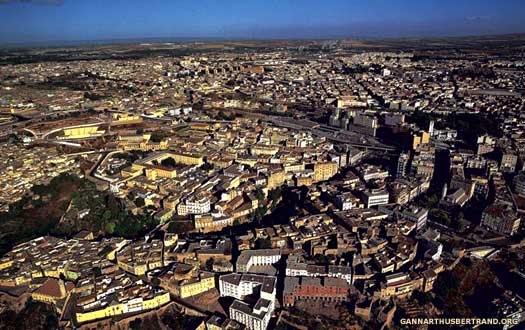 The port city of Mostaganem was founded in the eleventh century, although it was based on an earlier settlement which was known as Cartenna by the Carthaginians The port city of Mostaganem was founded in the eleventh century, although it was based on an earlier settlement which was known as Cartenna by the Carthaginians |
|
|
| 1561 - 1562 |
Hasan Khüsro Aga |
Acting beylerbey. |
|
| 1562 |
Ahmad Pasha Qabia |
Acting beylerbey. |
|
| 1562 - 1567 |
Hasan Pasha |
Beylerbey for the third time, and in command for the fourth time. |
|
| 1563 |
Appointed to lead the fight against the Spanish, Hasan besieges Oran and then the neighbouring Mers El Kébir. Both are Spanish holdings and both attacks are repulsed after stubborn defending and with the arrival of a Spanish relief fleet. |
|
|
| 1567 |
Hasan Pasha is recalled to Constantinople where he is granted the position of commander-in-chief of the Ottoman fleet. He retains the position, taking part in the Ottoman failure at the Battle of Lepanto in 1571 and dying in Constantinople in 1572. |
|
|
| 1567 - 1568 |
Mehmed Pasha |
Son of Salah Raïs. Acting beylerbey. |
|
| 1568 - 1577 |
Ölj Ali Pasha / el-Euldj 'Ali |
|
|
| 1568 - 1570 |
Mehmed Pasha |
Acting beylerbey (for the second time), now for Ölj Ali Pasha. |
|
| 1569 |
In October, Ölj Ali Pasha marches his forces overland to attack Hafsid Sultan Ahmad III of Tunis, following the latter's restoration by the Spanish. With about 5,000 troops, he defeats Ahmad and takes Tunis, while Ahmad finds refuge in the nearby Spanish fort at La Goulette. |
|
|
| 1571 - 1574 |
Arab Ahmed |
Acting beylerbey for Ölj Ali Pasha. Died 1578. |
|
| 1574 - 1577 |
Qa'id Ramadan |
Former governor of Ifriqiyya. Acting beylerbey for Ölj Ali Pasha. |
|
| 1577 - 1580 |
Hasan Pasha Veneziano |
First official pasha of Algiers from May 1577. |
|
| 1578 - 1580 |
Spain sends an embassy to Constantinople to negotiate a truce which leads to formal peace in August 1580. Algiers quickly becomes a formalOttoman territory instead of a military headquarters, and a more normal imperial administration is set up in Algiers, led by the appointed pashas. Each pasha has a three year term of office with the focus of their duties being to consolidate Ottoman power in the Maghreb. This change of focus does not change Algiers' main form of income, however. The activities of the Barbary pirates continues unabated. |
|
|
| 1580 - 1582 |
Jafer Pasha |
|
|
| 1582 |
Qa'id Ramadan |
Sardinian renegade. Previously acting beylerbey (1574). |
|
| 1582 - 1588 |
Hasan Pasha Veneziano |
Pasha for the second time. Died after leaving office. |
|
| 1588 |
Deli Ahmed Pasha is appointed pasha of Algiers in order to end recent power struggles in the city to gain the office. He is also responsible for frequent raids along the European coastline, coming away with great riches. |
|
|
| 1588 - 1589 |
Deli Ahmed Pasha |
Died during a campaign to restore Ottoman control to Tripoli. |
|
| 1589 - 1592 |
Khizr Pasha / Haydar |
|
|
| c.1590 - 1593 |
A large-scale insurrection by the Kabyles begin in the interior. Such is its scale that it takes the pashas of Algiers more than half a century to quell it. Problems in Algiers mount just two years later when the 'Tunisian Plague' hits it, followed by the destruction of the harbour during a hurricane in 1593. |
|
|
| 1592 - 1594 |
Shaban Pasha |
|
|
| 1594 |
Mustafa Pasha |
|
|
| 1594 - 1596 |
Khizr Pasha |
Pasha for the second time. |
|
| 1596 |
Khizr Pasha is replaced after generally annoying everyone he has to deal with, creating a sense of anarchy in Algiers with his poor government, and seizing fifteen thousand crowns that belonged to his predecessor under the pretext of diverting them for the reconstruction of the port. In the end, the Turkish faction in the city accuses him of intending to rule independently, while theFrench ambassador also lodges a complaint against him. |
|
|
| 1596 - 1598 |
Mustafa Pasha |
Pasha for the second time. Removed from office. |
|
| 1598 |
Mustafa fails to quell the Kabyles. Instead, they ravage Mitidja and besiege Algiers itself for eleven days. Mustafa is replaced for his failure and is imprisoned once he reaches Constantinople. |
|
|
| 1598 - 1599 |
Hasan Pasha Bu Risa |
Oversaw a period of anarchy in Algiers. |
|
| 1599 - 1603 |
Süleyman Pasha |
Real name Joseph Anthelme Sève of Lyon in France. |
|
| 1603 - 1605 |
Khizr Pasha |
Pasha for the third time. Killed. |
|
| 1603 - 1605 |
Appointed to Algiers for a third time, it seems that Khizr Pasha has learnt nothing from his previous periods of office there. He takes revenge against the French, seizing funds that are intended to compensate French merchants for loss of goods. In 1604 he attacks both the French ambassador and the French fort, massacring or enslaving its occupants. When King Henry IV of France requests Ottoman aid in the matter, Köse Mustafa Pasha is sent to Algiers to throttle Khizr, ending his trouble-making ways for good. 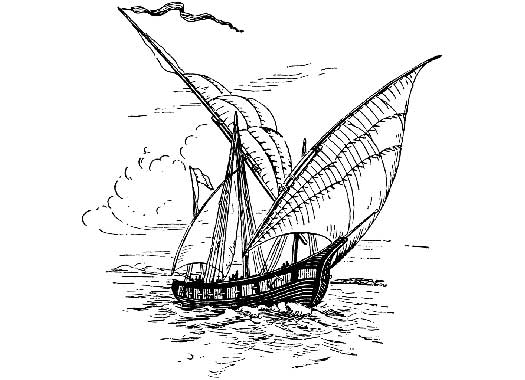 Barbary corsairs in this period raided European merchant shipping, including English vessels, pretty much at will, a danger that would have to be confronted with full scale military campaigns in the seventeenth century Barbary corsairs in this period raided European merchant shipping, including English vessels, pretty much at will, a danger that would have to be confronted with full scale military campaigns in the seventeenth century |
|
|
| 1605 - 1607 |
Köse Mustafa Pasha |
Replacement for Khizr Pasha. |
|
| 1607 - 1610 |
Rizvan Pasha |
|
|
| 1610 - 1613 |
Köse Mustafa Pasha |
|
|
| 1613 - 1616 |
Shaykh Huseyin Pasha |
|
|
| 1616 |
Köse Mustafa Pasha |
Pasha for the third time. |
|
| 1616 - 1617 |
Süleyman Katanya |
|
|
| 1617 - 1619 |
Shaykh Hüseyin Pasha |
Pasha for the second time, from January 1617. |
|
| 1619 - 1621 |
Sherif Koça / Koja |
|
|
| 1621 |
Khizr Pasha |
Pasha for the fourth time. |
|
| 1621 |
Mustafa Pasha |
|
|
| 1622 |
Khüsrev Pasha |
Later became grand vizier to the Ottoman sultan. |
|
| 1622 - 1623 |
The office of pasha is vacant for a short time. |
|
|
| 1623 - 1626 |
Murad Pasha |
|
|
| 1626 - 1627 |
The office of pasha is vacant for the second time. |
|
|
| 1627 - 1629 |
Hüseyin Pasha |
|
|
| 1629 - 1629/30 |
Yunus |
|
|
| 1629/30 - 1634 |
Hüseyin Pasha |
Pasha for the second time. |
|
| 1634 - 1636 |
Yusuf Pasha |
|
|
| 1636 - 1638 |
Abu'l-Hasan Ali Pasha |
|
|
| 1638 - 1640 |
Shaykh Hüseyin Pasha |
|
|
| 1640 - 1642 |
Abu Djamal Youssef Pasha |
|
|
| 1642 - 1645 |
Mehmed Brusali Pasha |
|
|
| 1645 |
Despite the lack of available data on the later pashas of Algiers, one name does stand out. Ali Biçnin is a former Christian whose Arab name is a bastardisation of an Italian name, probably Puccini or similar. Having been captured as a boy in 1578 by Hasan Pasha Veneziano, first official pasha of Algiers, he rises through the ranks of the privateering Algiers navy to become a very rich admiral. His possible (but contested) seizure of the post of pasha is probably linked to his rebellion against his Ottoman overlord, when he refuses to obey a general order to attack the Venetians and the Knights of St John. The sultan orders his assassination, and in the same year his own servant poisons his drink. 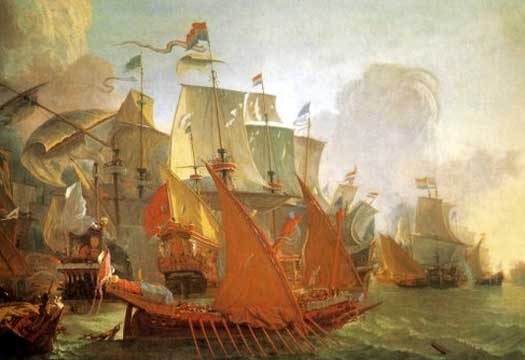 Ali Biçnin Pasha rose through the ranks of the navy of Algiers, its Barbary corsair fleet which in this oil by Lieve Pietersz Verschuir is being confronted by a Dutch fleet Ali Biçnin Pasha rose through the ranks of the navy of Algiers, its Barbary corsair fleet which in this oil by Lieve Pietersz Verschuir is being confronted by a Dutch fleet |
|
|
| 1645 |
Ali Biçnin Pasha / Bijnin |
Former Christian slave. Assassinated. |
|
| 1645 - 1647 |
Mahmud Brusali Pasha |
|
|
| 1647 - 1650 |
Yusef Pasha |
|
|
| 1650 - 1653 |
Mehmed Pasha |
|
|
| 1653 - 1655 |
Ahmed Pasha |
|
|
| 1655 - 1656 |
Ibrahim Pasha |
|
|
| 1656 - 1658 |
Ahmad Pasha |
Pasha for the second time. |
|
| 1658 - 1659 |
Ibrahim Pasha |
Pasha for the second time. |
|
| 1659 |
Ismail Pasha |
|
|
| 1659 |
Khalil Aga |
First of the aghas ('chiefs'). Died. |
|
| 1660 - 1661 |
Ramadan Aga |
Died. |
|
| 1661 - 1665 |
Shaban Aga |
Died. |
|
| 1665 - 1671 |
Ali Aga |
Died. |
|
| 1671 |
The post of pasha is raised to that of dey by the Ottoman sultan. Algiers is already ruled on a semi-autonomous basis, and this increase in rank only serves to increase that detachment from Ottoman central authority. |
|
|
|
|
|
|
| Deys of Algiers AD 1671 - 1830 Takeover of the Algiers region by the Ottoman empire from 1555 meant that it had been governed as an autonomous province from the Barbary corsair capital at Algiers. In 1671 the deys, the Ottoman governors of the region, began to rule a semi-autonomous Algiers that was increasingly drawn away from Ottoman authority, seemingly following a coup in that very same year - 1671. By 1711 they were completely independent in all but name. Following the removal in 1686 of the self-appointed dey, Mezzo Morto, the deys were often selected for office by the Ottoman militia or by the Barbary corsair captains. The problems caused by Berber pirates in the Mediterranean during this period became serious enough to result in several of the major European powers launching punitive raids on Algiers. Not only were the pirates attacking European trading, they were also taking Christian prisoners, a situation that could not be allowed to persist. Unfortunately, dealing with the problem was like swatting flies. Piracy would be disrupted briefly and peace would return to the shipping lanes until the Berbers had regrouped and were able to launch fresh attacks. Denmark conducted a raid in 1770, France conducted five between 1661-1688, England three between 1622-1672, and Spain three between 1567-1783. Christian captives were rescued, but there must have been many more who were not so lucky. (Information by Peter Kessler, with additional information from Oppgjøret med røverstaten Algier 1769-72, Torbjørn Ødegaard (Marinemuseet, Horten, 2010, in Norwegian), from Comment l'Algérie devint française (1830-1848), Georges Fleury, and from External Links: The War in Algiers (in Danish), and Encyclopaedia Britannica, andThe Conquest of Algiers, Camille Rousset (in French), andWorld Statesmen.) |
|
|
|
| 1671 - 1682 |
Muhammad I |
First independent dey of Algiers. |
|
| 1681 - 1683 |
Such is the nuisance caused by the Berber pirates in the Mediterranean that King Louis XIV of France charges Admiral Abraham Duquesne with the task of fighting them. A large-scale attack on Algiers is ordered in 1682 to assist Christian captives, and this is concluded the following year. The raid is by no means a one-off, with various European powers launching similar raids on Algiers during the seventeenth and eighteenth centuries. 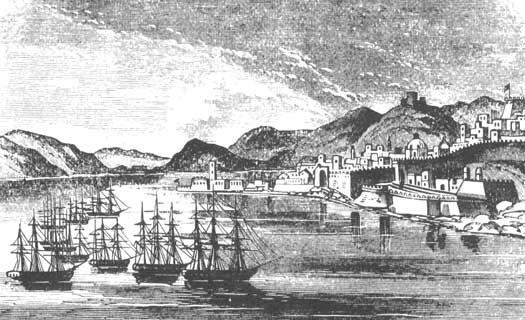 Algiers came under bombardment several times during the seventeenth and eighteenth centuries, usually due to its role in leading Berber piracy raids Algiers came under bombardment several times during the seventeenth and eighteenth centuries, usually due to its role in leading Berber piracy raids |
|
|
| 1682 - 1683 |
Hassan I Baba / Baba Hassan |
Assassinated by Hüseyin I. |
|
| 1683 |
Hassan I Baba offers his naval commander, Hüseyin 'Mezzo-morte' (Italian for 'half-dead', which refers to a serious wound received in a fight), as a hostage to the French. Hüseyin, understandably put out by this, kills the dey and takes his place. It is he who is in command of Algiers during the next French attacks on the city. |
|
|
| 1683 - 1686 |
Hüseyin I 'Mezzo-morte' / Mezzo Morto |
Self-appointed successor to his victim, Hassan I. Died 1701/2. |
|
| 1685 - 1690 |
 The French bombard Tripoli and Algiers between 1685-1688, during which time Mezzo Morto is removed from office (but not killed). An ambassador is sent from Algiers to visit Louis XIV at the palace of Versailles to agree a treaty (in 1690) which secures peace for a century (more about Versailles is available via the feature link). The French bombard Tripoli and Algiers between 1685-1688, during which time Mezzo Morto is removed from office (but not killed). An ambassador is sent from Algiers to visit Louis XIV at the palace of Versailles to agree a treaty (in 1690) which secures peace for a century (more about Versailles is available via the feature link). |
|
|
| 1686 - 1688 |
Ibrahim I |
|
|
| 1688 - 1695 |
Ahmed Shaban |
|
|
| 1694 - 1695 |
Having become involved in the internal fighting of the Muradids of Tunis, Ahmed Shaban now briefly captures Tunis itself, isolating Muhamed II temporarily. However, the Tunisians manage to throw off Algerian occupation and Muhamed regains his capital for the last year of his life. |
|
|
| 1695 - 1698 |
Hadji Ahmed I ben al-Hadji |
|
|
| 1698 - 1699 |
Baba Hassan II Chavush |
|
|
| 1699 - 1705 |
Hadj Mustafa I |
|
|
| 1702 |
Murad III of Tunis goes to war against Algiers, and the Ottoman court seems powerless to control him. One of his army commanders, Ibrahim Sharif, is visiting Constantinople at the time to recruit janissaries, but he is soon ordered to return to Tunis to arrest Murad. Instead he kills him and takes over his role as bey of Tunis. Then he assassinates the remaining young princes of the Muradid dynasty, the youngest of whom is aged four. |
|
|
| 1705 - 1706 |
Hüseyin II Khoja |
Not shown in all lists. |
|
| 1705 |
Ibrahim of Tunis manages, like his predecessor, to come into conflict with Algiers, and is soon captured by the dey of Algiers. A period of in-fighting is triggered between various factions of the Ottoman military forces in Tunis. The Husainid (Husaynid) dynasty is born when Husain, son of Ottoman Janissary 'Ali at-Turk and a North African mother, wins the battle and seizes control. He pronounces himself the bey of Tunis. 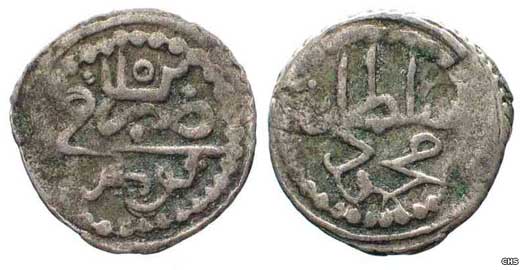 By the eighteenth century the currency of the dominant Ottoman empire was being used in the region, with these silver kharubs being minted in 1739 during the reign of Sultan Mahmud I By the eighteenth century the currency of the dominant Ottoman empire was being used in the region, with these silver kharubs being minted in 1739 during the reign of Sultan Mahmud I |
|
|
| 1706 - 1710 |
Muhammad II Bektash |
Not shown in all lists. |
|
| 1710 |
Deli Ibrahim II |
|
|
| 1710 - 1718 |
Ali II Shavush / Ali Chauch |
Sometimes referred to as pasha from 1711/1718. |
|
| 1711 |
The deys are recognised by the Ottoman emperor as being the official governors of Algiers, now being known in some sources as pasha-deys. In essence, though, they remain independent rulers of Algiers in all but name. |
|
|
| 1718 - 1724 |
Muhammad III ben Hassan |
|
|
| 1724 - 1731 |
Kurd 'Abdi / Abdy Pasha |
|
|
| 1726 |
The deys of Algiers also become nominally responsible for Tunis (until 1821), although how much actual influence they have there is open to question. The_bey_ of Tunis, Husain, seems to be just as independently-minded as both his immediate predecessors, and various plots and potential revolts are constantly bubbling under the surface. In the end Algiers has to remove Husain by force (in 1735). |
|
|
| 1731 - 1745 |
Ibrahim III ben Ramdan 'the Old' |
|
|
| 1745 - 1748 |
Kücük Ibrahim IV |
|
|
| 1748 - 1754 |
Muhammad IV Pasha 'El Retorto' |
|
|
| 1754 - 1766 |
Baba Ali III Pasha |
|
|
| 1766 - 1791 |
Muhammad V ben Othman |
|
|
| 1769 - 1772 |
Soon after becoming the dey of Algiers, Muhammad V demands that the Danish increase their annual tribute. They refuse but three Danish-Norwegian vessels are hijacked shortly afterwards. The Danish-Algerian War results, otherwise known as the Algerian Expedition, or The War Against Algeria. The outcome is not especially favourable for the Scandinavians once Algiers proves that it can defend itself. |
|
|
| 1784 - 1794 |
Protected from Barbary pirates during the American Revolution, thanks to its alliance with France,American shipping loses that protection from 1784 and the end of the Treaty of Alliance. Subsequently, US merchant shipping continually falls foul of successive pirate raids in the Mediterranean, launched fromMorocco and Algiers. Despite diplomatic efforts, large payments of tribute are demanded for the release of captured American crews, and the US regularly pays up to a million dollars a year to ensure the safe passage of its ships. |
|
|
| 1791 - 1798 |
Baba Hassan III |
|
|
| 1798 - 1805 |
Mustafa II ben Ibrahim |
|
|
| 1801 - 1805 |
Having recommissioned its navy in 1794, the USA is becoming increasingly reluctant to pay tribute to ensure the safe passage of its merchant ships in the Mediterranean. The pasha of Tripoli demands fresh tribute of the new government of Thomas Jefferson which is refused, so Tripoli declares war on the USA. Morocco and Algiers do not join Tripoli in the conflict. The small but highly modern American navy defeats Tripoli's vessels in a number of naval skirmishes during the First Barbary War, until Tripoli agrees peace terms and the US buys back its captured seamen. 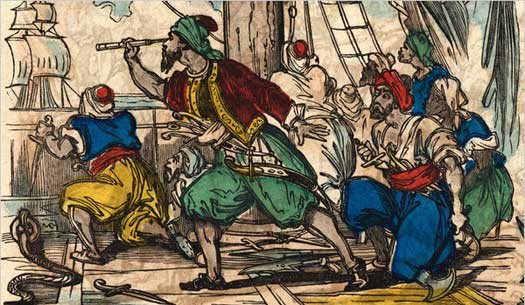 The somewhat colourful view of the Barbary pirates masked their relentless pursuit of captures and their accumulation of wealth at the expense of innocent merchantmen The somewhat colourful view of the Barbary pirates masked their relentless pursuit of captures and their accumulation of wealth at the expense of innocent merchantmen |
|
|
| 1805 - 1808 |
Ahmed II ben Ali |
|
|
| 1808 - 1809 |
Ali IV ar-Rasul ben Muhammed |
|
|
| 1809 - 1815 |
Ali V Haji |
Assassinated. |
|
| 1815 |
Muhammad VI Kharnadji |
In office for 17 days. Assassinated. |
|
| 1815 - 1817 |
Omar Agha |
Assassinated by janissaries. |
|
| 1815 - 1816 |
The Second Barbary War is fought by the USA in response to renewed pirate raids under Omar Agha while it has been preoccupied with the War of 1812. A squadron of US ships captures several Algerian vessels and, after negotiations, the dey of Algiers agrees to return American captives and vessels in return for a large one-off final payment. Although this concludes the war, it does not conclude the piracy threat, so the following year, Britain sends a 'diplomatic mission' that is eventually forced to bombard Algiers for nine hours on 27 August 1816. The dey loses many of his corsairs and shore defences, and the threat of organised Barbary piracy is ended once and for all. |
|
|
| 1817 - 1818 |
Ali VI ben Ahmed 'Khoja' |
Killed by plague. |
|
| 1818 - 1830 |
Hüseyin III / Hussein Dey |
Last dey of Algiers. Died 1848. Surrendered to France. |
|
| 1830 - 1834 |
Hüseyin III has attempted to placate the Europeans in their interest in Algiers by ensuring that the Jewish population enjoys religious freedom and some hostages are released. It does him little lasting good, however. France invades Algeria and conquers it in progressive stages between 1830-1834. Following much bloody fighting, the dey surrenders and is exiled after just three weeks of fighting and, following early French military command, governors administer the country for the French state. |
|
|
|
|
|
|
| French Governors of Algeria AD 1830 - 1962 The deys of Algiers had remained strong during the dominance of the Barbary corsairs, but the various expeditions against them had taken its toll. One last dreadful bombardment by the dominant Britain Royal Navy in 1816 had seemingly crushed Algerian strength, laying it open to conquest by Europeans who had just emerged from the Napoleonic Wars and a generation of conflict. Taking a minor insult to the French consul as a pretext, France invaded Algeria in 1834, although they already held territory taken in 1831-1833. It mattered not a jot that the governing dey, Hüseyin III, had already taken at least some steps towards making life more comfortable in Algiers for religious groups and imprisoned captives. A long and bloody war of attrition followed in which French rule was slowly applied over the whole country, starting with Oran on 4 January 1831. Bone followed in 1832, Bougie in 1833, and then Arzew on 10 July 1833, and Mostaganem on 28 July 1833. In 1836, Tlemecen fell on 8 January, and in the following year, Constantine was taken. Djidjelli fell on 23 May 1839, Miliana on 8 June 1840, Zaateha Oasis on 26 November 1849, and finally Laghouat on 4 December 1852. France now ruled Algiers and its territories, collectively named Algeria. The application of French rule saw an influx of tens of thousands of French settlers, plus many others from Southern Europe, with modern, highly productive farms being created. French construction also created European-style city centres, bringing Algeria fully into the modern age. Resistance still existed, however, especially in the form to the very able Abd-el-Kader from 1832 (Information by Peter Kessler, with additional information from Comment l'Algérie devint française (1830-1848), Georges Fleury, and from External Links: Encyclopaedia Britannica, andThe Conquest of Algiers, Camille Rousset (in French).) |
|
|
|
| 1830 |
Louis |
FirstFrench military commander. Comte de Chaisne de Bourmont. |
|
| 1830 |
French troops defeat the dey's forces at the Battle of Staouéli on 19 June 1830. The French enter Algiers on 5 July after just three weeks of campaigning and the dey agrees to surrender in exchange for his freedom. He leaves Algiers five days later, with his family, accepting exile in [ Italy](../KingListsEurope/ItalyKingdom.htm#Austria Restored). The Ottoman bey of Constantine (capital of north-western Algeria) becomes France's greatest opposition in the region, with a well-organised resistance to invasion. 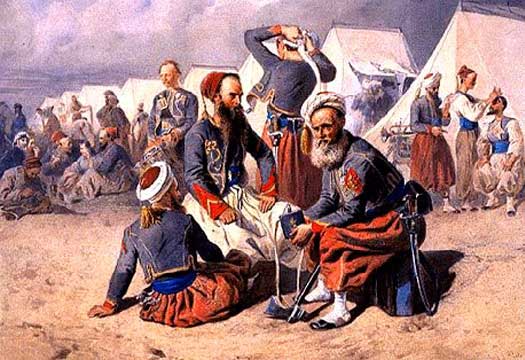 The French recruited their first units of zouaves in October 1830, shortly after gaining control of Algiers, and these troops would serve faithfully in many theatres of conflict, including the Crimea where they are shown here The French recruited their first units of zouaves in October 1830, shortly after gaining control of Algiers, and these troops would serve faithfully in many theatres of conflict, including the Crimea where they are shown here |
|
|
| 1830 - 1837 |
Ahmad ibn Muhammad |
Bey of Constantine and highest Ottoman power in the region. |
|
| 1830 - 1831 |
Bertrand |
Comte Clauzel. |
|
| 1830 |
On 1 December 1830, the new French king, Louis Philippe of Orleans, orders René Savary, duc de Rovigo, to take command of the French possessions of Algiers. When he takes up his post on 6 December 1831, he secures Bone and begins to expand French control outwards, but his violent repression of resistance not only causes him to be recalled, it triggers the creation of an organised resistance movement in 1832. |
|
|
| 1831 |
Pierre |
Baron Berthezène. |
|
| 1831 - 1833 |
René Savary |
Duc de Rovigo. |
|
| 1832 |
Muhyi ad Din |
Leader of a religious brotherhood who fought the French. |
|
| 1832 |
Encouraged by Sultan Abderrahmane of Morocco, Algerian Islamic scholar Abd-el-Kader leads the struggle against the French invasion and occupation of the country. Known as the emir of Mascara, he gains a following of several tribes, thanks to which he is able to conduct a highly successful guerrilla campaign against the French. His treatment of captured French troops is regarded as being honourable, while his political ability is considerable. Sultan Abderrahmane is also called upon by the inhabitants of the Algerian city of Tlemcen to invade and protect it from the French. This he does, and his nephew, Prince Moulay Ali, is named caliph of Tlemcen. |
|
|
| 1832 - 1843 |
Abd-el-Kader / Abd al Qadir |
Son of Muhyi. Emir of Mascara. Died 1883. |
|
| 1833 - 1834 |
Théophile |
Baron Voirol. |
|
| 1834 |
The French occupation of the territory of Algiers is formally confirmed on 22 July as the 'French Possessions of North Africa', making it a French colony. Five days later, the first governor-general takes up his office. Sultan Abderrahmane of Morocco refuses requests to abandon Tlemcen. |
|
|
| 1834 - 1835 |
Jean Baptiste |
First governor-general. Comte Drouet d'Erlon. |
|
| 1835 - 1837 |
Bertrand |
Comte Clauzel. Previously a military commander. |
|
| 1835 |
Bertrand Clauzel immediately triggers a land grab by promising to subsidise French colonists who wish to settle, visualising Algiers as prime cotton-growing territory. The grab is pursued vigorously and with absolute disregard for the native population. |
|
|
| 1837 |
Charles-Marie Denys |
Comte de Damrémont. |
|
| 1837 - 1839 |
In the same year that Constantine falls to the French (13 October 1837), Abd-el-Kader signs the Treaty of Tafna with Thomas Robert Bugeaud. In it he recognises France's control of Algiers and Oran, while he is recognised as the sovereign of the interior, roughly two-thirds of the country's territory. This is the first official usage of 'Algeria' to describe the entire country, Mediterranean coast and inland areas together. The French break the treaty in 1839 by using a mountain pass in Abd-el-Kader's territory, and his guerrilla struggle is renewed. |
|
|
| 1837 - 1840 |
Sylvain Charles |
Comte Valée. |
|
| 1839 |
The French Possessions of North Africa are re-termed the 'French Algerian Possessions'. |
|
|
| 1841 - 1847 |
Thomas Robert Bugeaud |
Duc d'Isly. |
|
| 1842 - 1843 |
The campaigns of Emir Abd-el-Kader begin to fail, thanks to the increasing number ofFrench troops brought into the country and the brutal scorched-earth policy they follow in warfare against the native defenders. Finally, Abd-el-Kader is forced to surrender and is exiled to France, where his activities can be monitored. Other, lesser resistance movements spring up, notably one led by Lalla Fadhma N'Soumer, ably assisted by the redoubtable fighter Bou Baghla (killed in 1854). 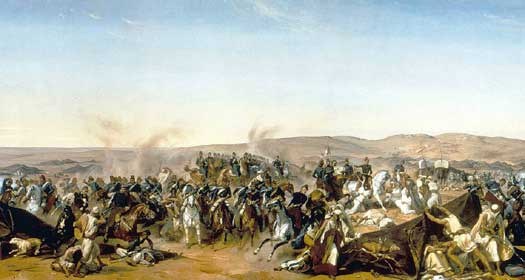 The Battle of Smala in 1843 was the turning point for the French, when their last major opposition to colonial rule, Emir Abd-el-Kader, was defeated The Battle of Smala in 1843 was the turning point for the French, when their last major opposition to colonial rule, Emir Abd-el-Kader, was defeated |
|
|
| 1845 - 1847 |
Louis Juchault de Lamoricière |
Acting governor-general in place of Bugeaud. |
|
| 1845 - 1848 |
The territories that are part of French-occupied Algiers are officially named Algeria in 1845. Just three years later, Algiers, Constantine, and Oran are all made French departments as part of the reorganisation by the new [ French Second Republic](../KingListsEurope/FranceFranks.htm#Second Republic) in which all of Mediterranean Algeria is integrated fully into France. French occupation still doesn't extend into the deeper inland territories, but French military control of those occupied regions outside the departments continues. |
|
|
| 1847 |
Marie-Alphonse Bedeau |
Acting governor-general in place of Bugeaud. |
|
| 1847 - 1848 |
Henri Eugène Philippe Louis d'Orléans |
Duke d'Aumale. |
|
| 1848 |
Louis Eugène Cavaignac |
|
|
| 1848 |
Nicolas Anne Théodule Changarnier |
|
|
| 1848 - 1850 |
Viala |
Baron Charon. |
|
| 1850 - 1851 |
Alphonse Henri |
Comte d'Hautpoul. |
|
| 1851 |
Aimable Jean Jacques Pélissier |
|
|
| 1851 - 1858 |
Jacques Louis César Alexandre |
|
|
| 1852 |
Prince Louis Napoleon Bonaparte, who has been president of France since December 1848, now declares himself emperor, and the republic is replaced by the [ Second Empire](../KingListsEurope/FranceFranks.htm#Second Empire). He returns Algeria to military control, terminating the French-style departments that were created in 1848. |
|
|
| 1858 |
A Ministry of Algerian Affairs is formed to supervise the country's administration through a military governor-general who is assisted by a civil minister. Military commanders replace governors-general. |
|
|
| 1858 - 1859 |
Patrice Maurice de Mac-Mahon |
Military commander. |
|
| 1859 |
Philippe Antoine Gues-Viller |
Military commander. |
|
| 1859 - 1860 |
Edmond Charles de Martimprey |
Military commander. |
|
| 1860 - 1864 |
Aimable Jean Jacques Pélissier |
Governor-general for the second time. |
|
| 1864 |
Edmond Charles de Martimprey |
Acting governor-general. Former military commander. |
|
| 1864 - 1870 |
Patrice Maurice de Mac-Mahon |
Former military commander. |
|
| 1870 |
Louis |
Acting governor-general. Baron Durrieu. |
|
| 1870 |
Jean Louis Marie Walsin-Esterhazy |
Acting governor-general. |
|
| c.1870 - 1871 |
Between about 1870 and March 1871, Mayor of Algiers Benoît François Romuald Vuillermoz takes advantage of the toppling of the [ Second Empire](../KingListsEurope/FranceFranks.htm#Second Empire) and himself topples the governor-general in Algeria, setting himself up as the chief authority. An extraordinary commissioner is appointed to deal with the situation. |
|
|
| c.1870 - 1871 |
Benoît François Romuald Vuillermoz |
Head of the Committee of Defence. Mayor of Algiers. Died 1877. |
|
| 1870 - 1871 |
Charles du Bouzet |
First extraordinary commissioner. Also prefect of Oran. |
|
| 1871 |
Alexis Lambert |
Second extraordinary commissioner. Also prefect of Oran. |
|
| 1871 |
Official authority in Algeria is restored and changes are made to improve the situation there, especially for refugees from the lost Alsace-Lorraine region who are demanding new settlement land in Algeria. A civilian governor-general is appointed, but the changes, and a general grain shortage which leads to famine amongst the Muslims, trigger a revolt in the Kabylie. This turns into the most serious incident since 1843, and stern punishment is imposed once the situation has been brought under control. 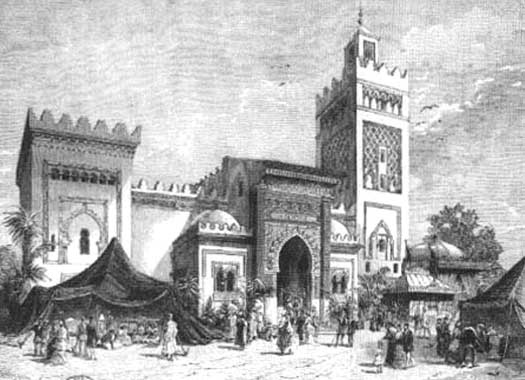 The 1867 Universal Exposition in Paris provided the chance to present the very best of France's most important Muslim colony to the world The 1867 Universal Exposition in Paris provided the chance to present the very best of France's most important Muslim colony to the world |
|
|
| 1871 - 1873 |
Louis Henri |
Governor-general. Comte de Gueydon. |
|
| 1873 - 1879 |
Antoine Eugène Alfred Chanzy |
|
|
| 1879 - 1881 |
Albert Grévy |
Acting governor-general. |
|
| 1881 - 1891 |
Louis Tirman |
|
|
| 1881 |
France invades Tunisia from Algeria, removing Ottoman control of the country and creating a protectorate. |
|
|
| 1891 - 1897 |
Jules Cambon |
|
|
| 1896 |
The French Parliament votes to annexe Madagascar. The Merina monarchy comes to an end, and the royal family is exiled to Algeria. French governors are appointed to control the island. |
|
|
| 1897 - 1898 |
Louis Lépine |
|
|
| 1898 - 1900 |
Édouard Laferrières |
|
|
| 1900 - 1901 |
Charles Célestin Jonnart |
Acting governor-general. |
|
| 1901 - 1903 |
Paul Révoil |
|
|
| 1903 |
Maurice Varnier |
Acting governor-general. |
|
| 1903 - 1911 |
Charles Célestin Jonnart |
Acting governor-general for the second time. |
|
| 1911 - 1918 |
Charles Lutaud |
|
|
| 1914 - 1918 |
Having jointly guaranteed in 1839 to support the neutrality of Belgium, when the country is invaded by Germany, Belgium's allies, Britain, France, and Russia, are forced to declare war at midnight on 4 August against Imperial Germany and [Austria](../KingListsEurope/GermanyAustria.htm#Habsburg Emperors) in what becomes known as the Great War or First World War. The German armies head towards Paris before being halted and retreating to what becomes the Western Front just inside French territory. The French army includes units from its various colonial territories, including Algeria, French Sudan, and Tunisia. 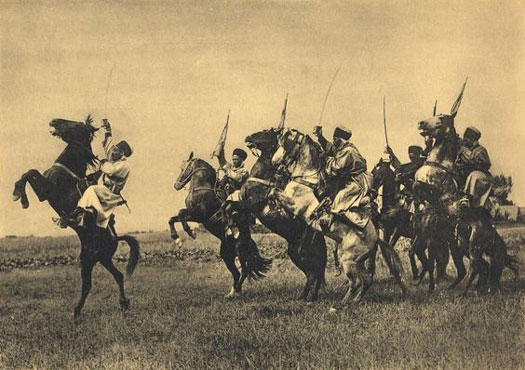 Spahis formed light cavalry regiments for the French armed forces during the Great War, being recruited from as far afield as Algeria, Tunisia, and Turkey, with a regiment of them surviving in today's French armed forces (albeit with horses swapped for tanks) Spahis formed light cavalry regiments for the French armed forces during the Great War, being recruited from as far afield as Algeria, Tunisia, and Turkey, with a regiment of them surviving in today's French armed forces (albeit with horses swapped for tanks) |
|
|
| 1918 - 1919 |
Charles Célestin Jonnart |
Acting governor-general for the third time. |
|
| 1919 - 1921 |
Jean Baptiste Eugène Abel |
|
|
| 1921 - 1925 |
Théodore Steeg |
|
|
| 1925 |
Henri Dubief |
Acting governor-general. |
|
| 1925 - 1927 |
Maurice Viollette |
|
|
| 1927 - 1930 |
Pierre Louis Bordes |
|
|
| 1930 - 1935 |
Jules Gaston Henri Carde |
|
|
| 1935 - 1940 |
Georges Le Beau |
|
|
| 1940 - 1944 |
The Nazi German invasion of Poland on 1 September 1939 is the trigger for the Second World War. With both France and Britain pledged to support Poland, both countries have no option but to declare war on 3 September. After a lightening march through the [Netherlands](../KingListsEurope/FranceHolland.htm#Kingdom of Holland %28Orange%29) and Belgium, France is occupied by the Nazi war machine in 1940, and Vichy (Fascist) rule is allowed as a puppet state in southern France, Algeria, and Tunisia, although the Tunisians generally look on with an air of quiet satisfaction at France's humiliation. Algeria remains loyal to the Vichy regime until 1942, but then switches to the Free French. |
|
|
| 1940 - 1941 |
Jean Charles Abrial |
|
|
| 1941 |
Maxime Weygand |
|
|
| 1941 - 1943 |
Yves Charles Chatel |
|
|
| 1943 |
Marcel Peyrouton |
|
|
| 1943 - 1944 |
Georges Catroux |
Re-emerged as resident minister (1956). |
|
| 1944 - 1948 |
Yves Chataigneau |
|
|
| 1945 |
On 8 May a massacre of about a hundred French citizens takes place at Sétif. This follows protests by Algerians for greater political freedom in their own country, but it results in a brutal crackdown by the authorities in which perhaps six thousand Algerians are killed. This incident is almost certainly directly responsible for increasing discontent and the eventual outbreak of the Algerian War of Liberation in 1954. |
|
|
| 1948 - 1951 |
Marcel Edmond Naegelen |
|
|
| 1951 - 1955 |
Roger Léonard |
|
|
| 1954 |
Attempting to free the country from French rule, the long and bloody Algerian War of Liberation begins with the National Liberation Army (FLN) fighting using guerrilla tactics. Non-Algerian communities begin to emigrate in large numbers, whether Muslims, Christians, or Jews. Many of the latter prefer France, although a sizable number do end up in Israel. 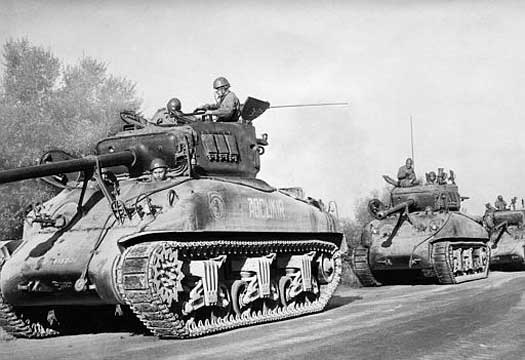 French tanks patrolled the roads in Algeria from the start of the Algerian War in 1954, this unit being pictured near Blida, where they hunted guerrilla bands in the hills French tanks patrolled the roads in Algeria from the start of the Algerian War in 1954, this unit being pictured near Blida, where they hunted guerrilla bands in the hills |
|
|
| 1955 - 1956 |
Jacques Émile Soustelle |
|
|
| 1956 |
Georges Catroux |
First of the resident ministers. Previously governor-general. |
|
| 1956 - 1958 |
Robert Lacoste |
|
|
| 1958 |
André Mutter |
|
|
| 1958 |
The Committee of Public Safety is formed in revolt against French rule. For May and June of this year, Algiers is not under French control. Revolutionary presidents of the Committee are shown in red. |
|
|
| 1958 |
Jacques Massu |
President of the Committee of Public Safety, 13 May-7 Jun. |
|
| 1958 |
Sid Cara |
Joint president, 23 May-7 Jun. |
|
| 1958 |
Raoul Albin Louis Salan |
First of the delegates-general. Re-emerged in Directorate (1961). |
|
| 1958 |
On 19 September 1958, the 'Provisional Government of the Algerian Republic' is established in exile in Tunisia by the FLN, which is dedicated to freeing Algeria of French control. |
|
|
| 1958 - 1960 |
Paul Albert Louis Delouvrier |
|
|
| 1960 - 1962 |
Jean Morin |
|
|
| 1961 |
The Directorate is formed as a further body of rebellion against French rule. Between 21-25 April four members of the directorate lead the opposition, and they are shown in red. |
|
|
| 1961 |
Maurice Challe |
Member of the Directorate. Died 1979. |
|
| 1961 |
André Zeller |
Member of the Directorate. Died 1979. |
|
| 1961 |
Edmond Jouhaud |
Member of the Directorate. Died 1995. |
|
| 1961 |
Raoul-Albin-Louis Salan |
Member of the Directorate. Former delegate-general. Died 1984. |
|
| 1962 |
Christian Fouchet |
High commissioner, 19 Mar-3 Jul. Died 1974. |
|
| 1962 |
Algeria wins independence from France, proclaiming the Algerian State on 3 July. This becomes the People's Democratic Algerian Republic on 25 September 1962 and a prime minister is elected to office in the same year. |
|
|
|
|
|
|
| Modern Algeria AD 1962 - Present Day Algeria is located on the North African coastline, bordered by Tunisia and Libya to the east,Niger and Mali to the south, Mauritania and Western Sahara to the south-west, and Morocco to the west. The state is officially titled the 'People's Democratic Republic of Algeria', with a capital at Algiers which is located at the centre of the country's coastal strip. In fact, the majority of the population lives along the coast. Algeria won independence from France in 1962, in a fight which cost the lives of more than a million Algerians. The Algerian state was proclaimed on 3 July 1962, which gained its modern form on 25 September 1962. The country's first independent head of state was Mohamed Ahmed Ben Bella, who served as prime minister until 17 September 1963, when he became the country's first president. However, Algeria's democracy was often hard-line and dictatorial in nature, if not to the extent that it became embroiled in the 'Arab Spring' of 2011, unlike neighbouring Tunisia. The country's remaining Jewish community was not permitted citizenship, so it promptly abandoned Algeria wholesale, dividing itself largely between France and Israel. The Sahara Desert covers more than four-fifths of Algeria's territory. Oil and gas reserves were discovered there in the 1950s, and the country supplies large amounts of natural gas to Europe. Energy exports form the backbone of the country's economy. This oil-rich inland area has long been the home to tribes of Berbers, mounted nomads who have fought Romans, Phoenicians, [Vandali](../KingListsEurope/BarbarianVandals.htm#Vandals and Alans),Eastern Romans, and also the Islamic empire when it arrived in 698. The Berbers have managed to retain their language and customs, and today make up about thirty percent of the country's population. (Information by Peter Kessler, with additional information from Modern Algeria: A History from 1830 to the Present, Charles Robert Ageron, and from External Links: BBC Country Profiles, and the Museum of Modern & Contemporary Art, Algiers (Nafas Art Magazine).) |
|
|
|
| 1962 |
Abderrahmane Farès |
Chairman of the Provisional Executive, 7-25 Sep. |
|
| 1962 |
Algeria becomes the People's Democratic Algerian Republic on 25 September 1962. The country's first independent head of state, elected on 27 September, is Mohamed Ahmed Ben Bella. He serves as prime minister until 17 September 1963, when he becomes president. 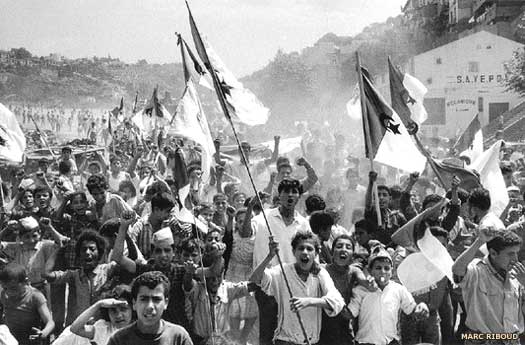 The Algerian Liberation Front was the political and military organisation which united Algerians for their revolutionary war and which led to independence in 1962 The Algerian Liberation Front was the political and military organisation which united Algerians for their revolutionary war and which led to independence in 1962 |
|
|
| 1962 |
Ferhat Said Ahmed Abbas |
Chairman of the National Constituent Assembly, 25-27 Sep. |
|
| 1962 - 1965 |
Mohamed Ahmed Ben Bella |
First prime minister and then president. Increasingly dictatorial. |
|
| 1963 |
Algeria fights the Sand War against Morocco when the latter claims sections of western Algerian territory. The war quickly bogs down into a stalemate which remains unresolved until an agreement is reached in 1972. |
|
|
| 1965 |
The increasingly authoritarian President Mohamed Ahmed Ben Bella is overthrown by his former defence minister, Houari Boumédienne. Unfortunately, Boumédienne continues the trend towards a stricter, socialist form of government. Political opposition is removed and the state's economy grows to depend more and more on oil revenues. |
|
|
| 1965 - 1978 |
Houari Boumédienne |
Overthrew his predecessor. Effectively a dictator. |
|
| 1975 - 1991 |
Having claimed the non-self-governing territory of [Spanish](../KingListsEurope/IberiaSpain.htm#Second Republic) Sahara as its 'Southern Provinces', Morocco now annexes the territory despite protests by Algeria, and it soon becomes known as the Western Sahara. This prompts the region's inhabitants to launch a guerrilla war which lasts until a ceasefire is agreed in 1991. Various subsequent attempts to conduct a peace process fail to break the political deadlock. |
|
|
| 1979 - 1992 |
Chadli Bendjedid |
Continued Boumédienne's dictatorial policies. |
|
| 1991 - 2002 |
During elections the Islamic Salvation Front wins the first round of voting. This prompts the military to step in and cancel the elections. Chadli Bendjedid is forced out of office and the long-running and brutal Algerian Civil War is triggered. Approximately 150,000 people are killed during it, and a state of emergency is declared as the military effectively govern the country. Fresh elections are held in 1995, and the war begins to run out of steam from 1998, with what is, essentially, a government victory. |
|
|
| 1992 |
Mohamed Boudiaf |
Chairman of the military High Council of State. Little real power. |
|
| 1992 |
The unfortunate Mohamed Boudiaf, full of good intentions in terms of reforming the country but completely stymied by the real power in the country - the military - is assassinated by a bodyguard while giving a public speech live on television. The assassin is tried and convicted, but his death sentence is never carried out, leading to the suspicion that he is a pawn of the military. |
|
|
| 1992 - 1994 |
Ali Kafi |
Chairman of the military High Council of State. |
|
| 1994 - 1995 |
Liamine Zéroual |
Chairman of the military High Council of State. |
|
| 1995 |
Free presidential elections are held in November 1995, a process which is won by Liamine Zéroual. He remains in the post until 1999 and supports limited negotiations in order to try and bring the Algerian Civil War to an end. The democratic process survives in Algeria, despite there seeming to be little political opposition to the incumbent president who succeeds Zéroual.  The Hoggar Mountains today sit in southern Algeria, but they cover an area of the Sahara and provided a western border to the northern reaches of the Kanem empire The Hoggar Mountains today sit in southern Algeria, but they cover an area of the Sahara and provided a western border to the northern reaches of the Kanem empire |
|
|
| 1999 |
An amnesty is announced for all participants in the civil war. Many former rebels are encouraged to lay down their arms and take part in the country's new push towards the full use of the democratic process. |
|
|
| 2001 |
After months of unrest the government agrees to a series of demands by the minority Berbers, including official recognition of their language. 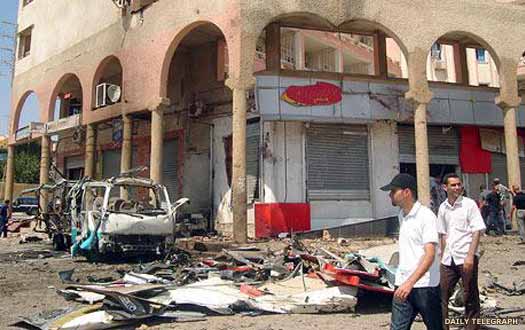 A new threat emerged on both sides of the Sahara in the early twenty-first century - in Mali and Algeria alike - in the form of extreme Islamic terrorist attacks, ostensibly aimed at foreigners but generally hurting ordinary people A new threat emerged on both sides of the Sahara in the early twenty-first century - in Mali and Algeria alike - in the form of extreme Islamic terrorist attacks, ostensibly aimed at foreigners but generally hurting ordinary people |
|
|
| 2011 |
A wave of popular protests against a deeply unpopular and dictatorial government forces the president of Tunisia to flee toSaudi Arabia, paving the way for fresh elections and a new start. The protests strike a chord in Arabs across North Africa and the Near East, and similar protests are triggered in Bahrain,Egypt, Libya,Morocco,Syria and Yemen. In Algeria, major protests break out in January over food prices and unemployment, with two people being killed in clashes with security forces. The government responds by ordering cuts to the price of basic foodstuffs, and also repeals the 1992 state of emergency law. |
|
|
 |
|
|
|
 The Hoggar Mountains today sit in southern Algeria, but they cover an area of the Sahara and provided a western border to the northern reaches of the Kanem empire
The Hoggar Mountains today sit in southern Algeria, but they cover an area of the Sahara and provided a western border to the northern reaches of the Kanem empire What are now Roman ruins at Batna in Algeria would still have been largely habitable during the Byzantine ownership of the region, some seven hundred years after the first Roman settlement there
What are now Roman ruins at Batna in Algeria would still have been largely habitable during the Byzantine ownership of the region, some seven hundred years after the first Roman settlement there The kingdom of Fez under Merinid control made the most of the confused political situation in North Africa by pouncing on the Zayyanids in 1337 and then on the Hafsids in 1347 to briefly recreate the former Alhomad kingdom (click or tap on map to view full sized)
The kingdom of Fez under Merinid control made the most of the confused political situation in North Africa by pouncing on the Zayyanids in 1337 and then on the Hafsids in 1347 to briefly recreate the former Alhomad kingdom (click or tap on map to view full sized) Algiers of this early modern period was a walled city with the Spanish Peñón de Algiers fort dominating its seaward approach - not that the Spanish had it all their own way when attempting to dominate the region
Algiers of this early modern period was a walled city with the Spanish Peñón de Algiers fort dominating its seaward approach - not that the Spanish had it all their own way when attempting to dominate the region The port city of Mostaganem was founded in the eleventh century, although it was based on an earlier settlement which was known as Cartenna by the Carthaginians
The port city of Mostaganem was founded in the eleventh century, although it was based on an earlier settlement which was known as Cartenna by the Carthaginians Barbary corsairs in this period raided European merchant shipping, including English vessels, pretty much at will, a danger that would have to be confronted with full scale military campaigns in the seventeenth century
Barbary corsairs in this period raided European merchant shipping, including English vessels, pretty much at will, a danger that would have to be confronted with full scale military campaigns in the seventeenth century Ali Biçnin Pasha rose through the ranks of the navy of Algiers, its Barbary corsair fleet which in this oil by Lieve Pietersz Verschuir is being confronted by a Dutch fleet
Ali Biçnin Pasha rose through the ranks of the navy of Algiers, its Barbary corsair fleet which in this oil by Lieve Pietersz Verschuir is being confronted by a Dutch fleet Algiers came under bombardment several times during the seventeenth and eighteenth centuries, usually due to its role in leading Berber piracy raids
Algiers came under bombardment several times during the seventeenth and eighteenth centuries, usually due to its role in leading Berber piracy raids The French bombard Tripoli and Algiers between 1685-1688, during which time Mezzo Morto is removed from office (but not killed). An ambassador is sent from Algiers to visit Louis XIV at the palace of Versailles to agree a treaty (in 1690) which secures peace for a century (more about Versailles is available via the feature link).
The French bombard Tripoli and Algiers between 1685-1688, during which time Mezzo Morto is removed from office (but not killed). An ambassador is sent from Algiers to visit Louis XIV at the palace of Versailles to agree a treaty (in 1690) which secures peace for a century (more about Versailles is available via the feature link). By the eighteenth century the currency of the dominant Ottoman empire was being used in the region, with these silver kharubs being minted in 1739 during the reign of Sultan Mahmud I
By the eighteenth century the currency of the dominant Ottoman empire was being used in the region, with these silver kharubs being minted in 1739 during the reign of Sultan Mahmud I The somewhat colourful view of the Barbary pirates masked their relentless pursuit of captures and their accumulation of wealth at the expense of innocent merchantmen
The somewhat colourful view of the Barbary pirates masked their relentless pursuit of captures and their accumulation of wealth at the expense of innocent merchantmen The French recruited their first units of zouaves in October 1830, shortly after gaining control of Algiers, and these troops would serve faithfully in many theatres of conflict, including the Crimea where they are shown here
The French recruited their first units of zouaves in October 1830, shortly after gaining control of Algiers, and these troops would serve faithfully in many theatres of conflict, including the Crimea where they are shown here The Battle of Smala in 1843 was the turning point for the French, when their last major opposition to colonial rule, Emir Abd-el-Kader, was defeated
The Battle of Smala in 1843 was the turning point for the French, when their last major opposition to colonial rule, Emir Abd-el-Kader, was defeated The 1867 Universal Exposition in Paris provided the chance to present the very best of France's most important Muslim colony to the world
The 1867 Universal Exposition in Paris provided the chance to present the very best of France's most important Muslim colony to the world Spahis formed light cavalry regiments for the French armed forces during the Great War, being recruited from as far afield as Algeria, Tunisia, and Turkey, with a regiment of them surviving in today's French armed forces (albeit with horses swapped for tanks)
Spahis formed light cavalry regiments for the French armed forces during the Great War, being recruited from as far afield as Algeria, Tunisia, and Turkey, with a regiment of them surviving in today's French armed forces (albeit with horses swapped for tanks) French tanks patrolled the roads in Algeria from the start of the Algerian War in 1954, this unit being pictured near Blida, where they hunted guerrilla bands in the hills
French tanks patrolled the roads in Algeria from the start of the Algerian War in 1954, this unit being pictured near Blida, where they hunted guerrilla bands in the hills The Algerian Liberation Front was the political and military organisation which united Algerians for their revolutionary war and which led to independence in 1962
The Algerian Liberation Front was the political and military organisation which united Algerians for their revolutionary war and which led to independence in 1962 The Hoggar Mountains today sit in southern Algeria, but they cover an area of the Sahara and provided a western border to the northern reaches of the Kanem empire
The Hoggar Mountains today sit in southern Algeria, but they cover an area of the Sahara and provided a western border to the northern reaches of the Kanem empire A new threat emerged on both sides of the Sahara in the early twenty-first century - in Mali and Algeria alike - in the form of extreme Islamic terrorist attacks, ostensibly aimed at foreigners but generally hurting ordinary people
A new threat emerged on both sides of the Sahara in the early twenty-first century - in Mali and Algeria alike - in the form of extreme Islamic terrorist attacks, ostensibly aimed at foreigners but generally hurting ordinary people